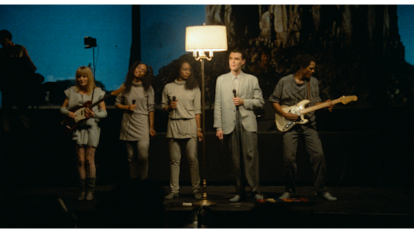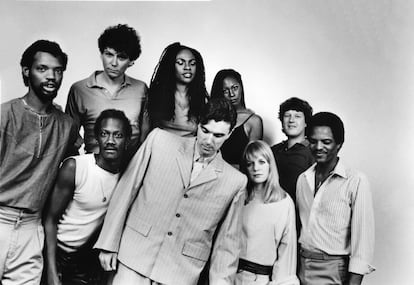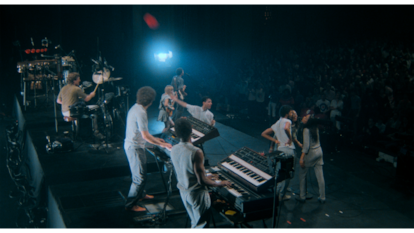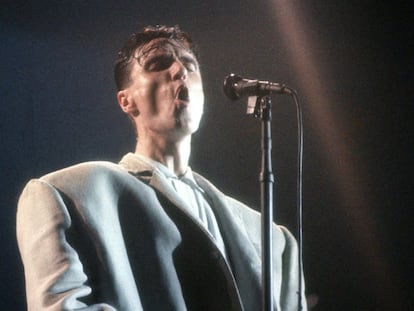Talking Heads on the filming of one of the greatest concerts ever: ‘We paid for everything’
Tina Weymouth and Chris Frantz share memories about the 1984 film, which has been remastered and is being screened in movie theaters


To watch Stop Making Sense, the film about the most important concert in the career of Talking Heads, is to see more than a live performance; it is to witness a visual symphony, where sound transcends the stage and movement becomes language. The band doesn’t just perform: it builds a world brick by brick, song by song. It is a choreography of chaos and control, where the erratic gestures of David Byrne, the band leader, are as much a part of the music as the rhythm that drives each note.
Throughout the show the costumes get bigger, the spaces get narrower and yet everything seems limitless. It is as if the music unravels what words alone cannot express: an experience in which logic dissolves and all that remains is the pure, raw emotion of being alive, together, in a fleeting moment of sound and movement.
Stop Making Sense was filmed by independent director Jonathan Demme (Silence of the Lambs) over four nights at the Pantages Theater in Los Angeles, California, and premiered in 1984. It has since been considered one of the greatest concerts ever filmed. In 2021, it was selected for preservation in the National Film Registry of the U.S. Library of Congress and now, 40 years later, it has been re-released after a 4K high-definition restoration screened around the world in both regular theaters and IMAX (it is the highest-grossing live event in its history).

Two key elements of the show, the drummer Chris Frantz and the bassist Tina Weymouth — founding members and partners since the early years of the band — spoke to EL PAÍS via a Zoom call from New York about the origins of the film, the preparations and the challenges they faced during the concerts, as well as its legacy. They also delved into their long relationship as a couple, their way of balancing family life with their musical careers, and their hopes for future musical projects such as Tom Tom Club, their other group with whom they have released six studio albums. The latest, Downtown Rockers, was released in 2012.
Question: How did the band prepare for a project of such magnitude?
Tina Weymouth: Jonathan Demme is a big music lover. He had seen the concert, so he approached us and said, “I think it would make a great film.” And we said, “Yeah, we think so too” (laughs). So that was perfect, because we had already seen at least one of his movies, and we loved it. Jonathan has a great sense of humor, and he always makes music very prominent in his films. So we thought, “Well, this is the right person to do it.” He also has a great team around him, like cinematographers and people who came on tour with us like Sandy McLeod, who mapped out all the camera shots ahead of time, so everything could be put into place when we finally shot the film. It was months of preparation. I think we did four nights at the Pantages Theater, but the first one was a complete wash. I was just told it was just a rehearsal, but I think they were doing some filming to find out where things needed to be, and so on. We all learned a lot from that night.
The music and photography is from different nights. So you don’t always get perfect lip sync, but it’s pretty perfect. Chris had a signal in his ear to start the song, just to figure out what the tempo was, so he wouldn’t play too fast or slow, and he was spot on. He’s a human clock. So things worked out really well, because we had a good crew. There was already a great relationship between our road crew and the band, so everything dovetailed perfectly. Everyone was very respectful of everyone else, and they were there to have a good time.
There were also some scary moments for the filmmakers themselves. One day, Jonathan, got stuck in traffic and wasn’t able to make it to our shoot. Obviously, the crew had to work too hard. They had to take the whole set apart so David [Byrne] could walk out onto the empty stage and start again, and we had to do a sound check every day with the film crew, so it had to be done not once, but twice. It was really a challenge, and yet it worked. Sometimes when things seem really difficult and impossible, people put their hearts and minds together, and they pull through very beautifully. It was a very good life lesson.
Q: And Chris, how did you feel creating this with the pressure of being the one in charge of keeping the beat and making the band stay together every night?
Chris Frantz: Fortunately I worked with a great band, and I had Steve Scales (the percussionist) next to me, Tina and David in front of me, Alex Weir on guitar, Bernie Worrell on keyboards, and Jerry Harrison on various instruments. I felt very comfortable with them. At that point we had worked together for a long time as an ensemble, and the concert evolved to the point where it was a really great show. It was never a bad show, but I think it evolved into something that was even better than we expected. I’m very proud of it, and very happy that we did it. You know, we were advised to pay for everything on our own, which was a great idea, because then we own it. It was a lot of money for us. We put it all on the table, and it worked out very well.
T.W.: It didn’t really make that much money the first time 40 years ago. But we were happy anyway. Little by little we felt it was growing. We thought, “It’s going to make the money back.” And last year, IMAX told us it was the best-selling live event in its history.

Q: Why do you think the film has become so iconic?
C.F.: Well, the show itself is, isn’t it? It’s classic in the sense that we didn’t use lasers or flashes or all the trappings of a big rock concert that you see today. In fact, it starts with a bare stage. People would come in and say, “What, where’s the band? Are they playing tonight?” And it builds very gradually until after five songs. There’s a great band out there, very powerful, and there were black people and white people together, rocking out. I think that’s why it’s had such good longevity.
T.W.: Yeah, there’s nothing in it that says, “Oh, it looks very 80s.” Everything we used was old theater stuff that could have been used at the Bataclan in Jean Cocteau’s time. It’s a very old style of theater that has been around for at least 150 years. But we were not actors, we were real people enjoying ourselves. And I think that’s part of the magic. It’s the incredible chemistry of the members and the way Jonathan Demme and his camera went from musician to musician, not focusing too much on where our fingers are, but watching, looking at our eyes. My impression was, “Wow, I have a really good seat in the venue. I can see, see the whole band from here.” And I had to, at times, remember to focus and be aware of the songs. Most of it was arranged in rehearsal. But we always left little spots for people to improvise, and that always gave us wonderful surprises. And we were happy and proud of ourselves when we were consistent. That was our ideal: to be consistently good and never forget the fans. You know, that spiritual connection was very important; you have to respect the fan.
Q: Is there anything you would have done differently during those concerts, either musically or visually? Chris, any thoughts on the turquoise shirt?
C.F.: (laughs) Tina says I wore the turquoise shirt because my other shirt was in the laundry. But I only wore it during the first part of the film. In the second half, I already had the one that was khaki, which was more in keeping with our costume directions. There’s nothing I would change... except maybe the shirt...

Q: Has the idea of releasing more music with your other musical project Tom Tom Club come up recently? And if so, what would the current sound or direction be like?
C.F.: We keep trying to get back into our studio. We recently renovated our home studio, which is really good, but we haven’t managed to get a lot done in it lately because we’ve been doing interviews [laughs]. But it’s not just that, it’s also family business and all kinds of things. Those are distractions that you get in this modern work, you know? But we do want to work on the project, and I’m sure we will.
Q: As an artist couple who have been together for so many years, what qualities have you come to appreciate most in each other as partners in life and in music?
T.W.: Oh my goodness, it’s too long a list, but I’m very, very lucky, because we met young, we fell in love and we have been very respectful of each other. I think that’s the key. And we work well together. We love each other, but we also love our work, and we can have different ideas. He has really good thinking and I respect that a lot, because I like smart men. That keeps the attraction going forever.
C.F.: I think Tina is also super intelligent, probably more than me. As you know, that’s a turn-on for a man. But also look how beautiful she is. And we have a good family life together. We just came back from a trip to France, in Brittany, where Tina’s mother is from and we are taking care of the family house and we do little projects together....
T.W.: Sorry to interrupt you but you’re right. It is fun. What I would add is that it’s part of having a normal life. Tom Tom Club is an amazing family of friends but we decided from the time we met that we both had ambitions to do these things artistically and musically, and at the same time we wanted to have a normal life. We weren’t going to “go Hollywood” [laughs]. I think that’s a very important aspect of keeping your sanity. when everything is chaos around you. Having a very normal kind of approach is pragmatic, but it’s also essential.
Sign up for our weekly newsletter to get more English-language news coverage from EL PAÍS USA Edition
Tu suscripción se está usando en otro dispositivo
¿Quieres añadir otro usuario a tu suscripción?
Si continúas leyendo en este dispositivo, no se podrá leer en el otro.
FlechaTu suscripción se está usando en otro dispositivo y solo puedes acceder a EL PAÍS desde un dispositivo a la vez.
Si quieres compartir tu cuenta, cambia tu suscripción a la modalidad Premium, así podrás añadir otro usuario. Cada uno accederá con su propia cuenta de email, lo que os permitirá personalizar vuestra experiencia en EL PAÍS.
¿Tienes una suscripción de empresa? Accede aquí para contratar más cuentas.
En el caso de no saber quién está usando tu cuenta, te recomendamos cambiar tu contraseña aquí.
Si decides continuar compartiendo tu cuenta, este mensaje se mostrará en tu dispositivo y en el de la otra persona que está usando tu cuenta de forma indefinida, afectando a tu experiencia de lectura. Puedes consultar aquí los términos y condiciones de la suscripción digital.
More information
Archived In
Últimas noticias
Most viewed
- Sinaloa Cartel war is taking its toll on Los Chapitos
- Oona Chaplin: ‘I told James Cameron that I was living in a treehouse and starting a permaculture project with a friend’
- Reinhard Genzel, Nobel laureate in physics: ‘One-minute videos will never give you the truth’
- Why the price of coffee has skyrocketed: from Brazilian plantations to specialty coffee houses
- Silver prices are going crazy: This is what’s fueling the rally










































